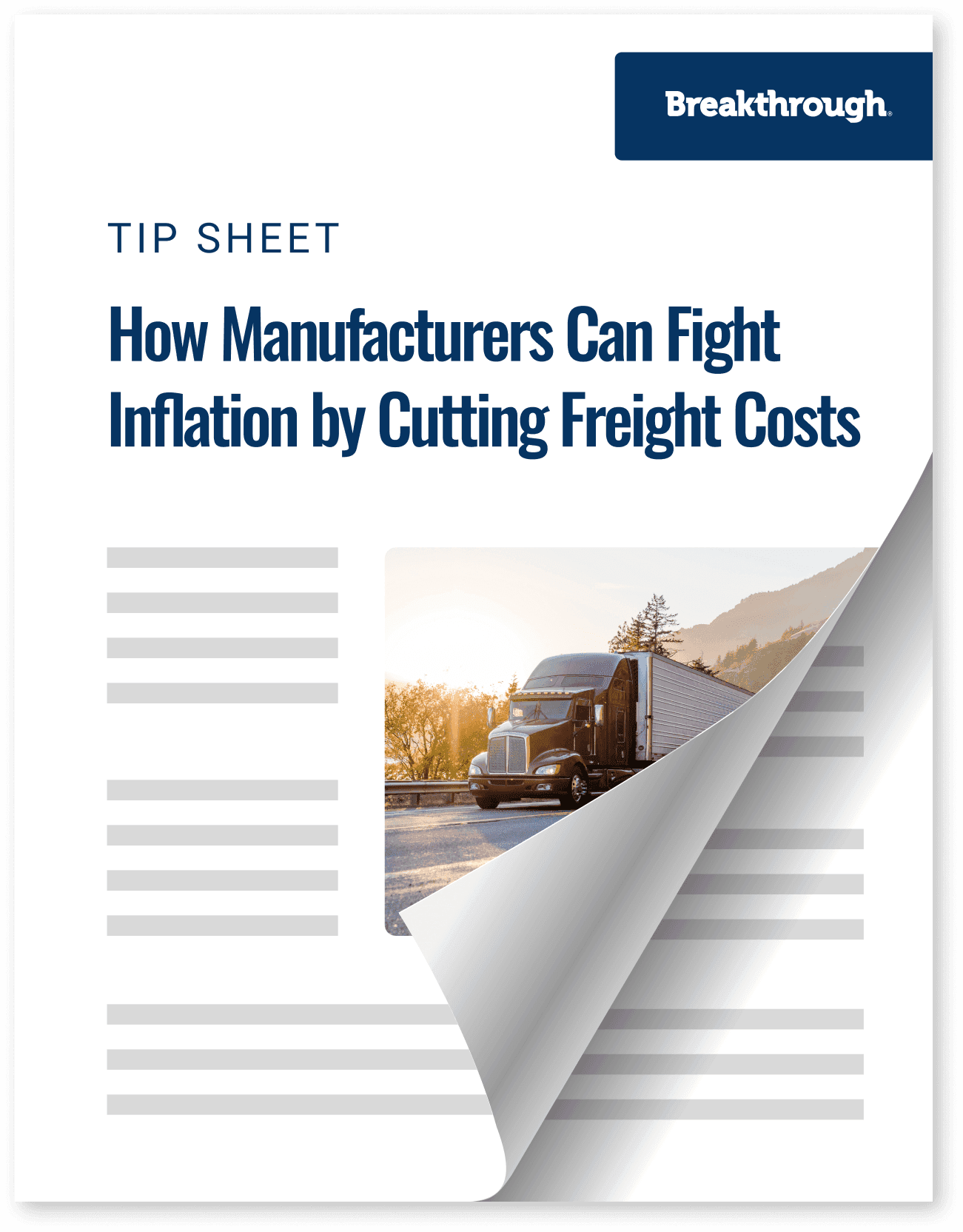Как производители могут бороться с инфляцией, сокращая расходы на грузоперевозки

Trending
Top Posts
Устойчивость и технологии
Понимание налогового кредита на производство чистого топлива в размере 45Z
4 мин чтения
октябрь 3, 2025
События на рынке
Почему цены на дизельное топливо стабильны, когда сырая нефть падает?
5 мин чтения
октябрь 2, 2025
События на рынке
Подготовка к новым законам Калифорнии о раскрытии информации о климате
4 мин чтения
сентябрь 30, 2025
6 мин чтения
май 17, 2019

Поделиться:
Оглавление
Просмотрите оглавление, чтобы сразу перейти к нужному разделу
Волатильность на рынке топлива, активность перевозчиков и множество других факторов способны существенно повлиять на бюджеты грузоотправителей. Погружение в исторические тенденции и данные за прошлые периоды помогает лучше понять эти явления, но постоянное информирование о текущих тенденциях и прогнозирование их влияния на будущее способствует разработке более перспективных стратегий.
В Breakthrough: наши решения по управлению топливом и цепочками поставок подчеркивают, что когда грузоотправители имеют четкое, объективное представление о своей сети - и о том, как изменение цен может повлиять на нее со временем, - эти знания позволяют им принимать хорошо обоснованные стратегические решения. Хотя прогнозирование может иметь разное применение в отношении топлива или грузов, оно является основным компонентом обоих аспектов Breakthrough Experience.
Для демонстрации того, что прогнозирование имеет значение для обоих направлений нашего бизнеса, операционные директора Дженни Вандер Занден и Хизер Мюллер объясняют ниже, как оно позволяет грузоотправителям обосновывать свои перспективные стратегии даже в условиях кажущейся непредсказуемости рынка перевозок.
Топливо - это изначально нестабильная часть общей стоимости доставки продукции на рынок, составляющая от двадцати пяти до тридцати процентов этих расходов. За последние пять лет это стало особенно очевидным, поскольку на рынке действовало множество факторов, которые приводили к периодам значительного снижения, кратковременным резким скачкам и росту цен. С точки зрения общих затрат на цепочку поставок это очень важно. Изменение цен на топливо по сравнению с предыдущим годом может привести к изменению общих расходов, что может значительно повлиять на общую рентабельность.
Чтобы помочь нашим клиентам учесть эту волатильность, наши ежемесячные публикации Market Advisor предлагают углубленный прогноз и перспективную перспективу рынка, отслеживая влияние ключевых событий и экономических показателей на цены. Эти знания могут быть использованы нашими клиентами для составления более точных бюджетов в своих организациях.
Геополитические риски, глобальные экономические перспективы, а также фундаментальные показатели спроса и предложения лежат в основе нашего прогноза цен на топливо, помогая клиентам осмыслить и понять ценовую ситуацию, в которой они находятся. Точность наших прогнозов исторически очень высока - почти 98 %, и в сочетании с рыночным подходом к возмещению расходов на топливо помогает грузоотправителям меньше зависеть от огромных колебаний, которые могут происходить при использовании программы возмещения расходов на топливо, основанной на индексах, таких как DOE. При этом у них есть уверенность в том, что они возмещают расходы на топливо на основе поведения рынка и находятся в одном ряду с хорошо управляемыми перевозчиками.

Еще один уникальный аспект этого подхода заключается в том, что мы становимся продолжением команды наших клиентов. Большинство наших клиентов исторически не имели отдельных экспертов по транспортной энергетике в своих командах по закупкам или операциям. Благодаря нашему решению клиенты получают информацию, необходимую им для описания изменений на рынке в своих организациях, без необходимости тратить дополнительное время на исследования. Речь идет не просто о цифрах для отчета, а о перспективах, которые они могут разложить на ключевые моменты и резюме для руководителей.
Наши прогнозы также включают в себя тщательный анализ меняющегося налогового ландшафта. У нас есть возможность смоделировать, как предстоящие налоговые изменения повлияют на уникальные транспортные бюджеты наших клиентов, основываясь на фактических данных их сети. Многие компании, которые не думают о стратегическом подходе к потреблению энергии, не имеют доступа к конкретным затратам, связанным с такими изменениями, что может привести к значительному искажению расходов на топливо.
Мы продолжаем ежемесячно обновлять эти прогнозы, чтобы клиенты имели самую свежую информацию на рынке. Грузоотправители, не использующие Breakthrough, зачастую не задумываются об общем количестве потребляемых ими галлонов, а тем более о том, как эти галлоны вписываются в их бюджет. Наша технология в сочетании с надежным прогнозированием дает возможность увидеть, как будут выглядеть расходы на топливо для грузоотправителя в будущем.
Это дает дополнительное преимущество, помогая выявить другие потенциальные области экономии. Хотя прогнозирование важно для составления годового бюджета, еще одним преимуществом Fuel Recovery является то, что она движется вместе с рынком, поэтому риск прогнозирования сводится к минимуму. Если грузоотправитель не укладывается в прогноз, мы также можем показать ему новые возможности для экономии средств.
Хотя исторически грузоотправители могут быть не так хорошо знакомы с прогнозированием топлива, в отрасли уделяется is огромное внимание прогнозированию грузоперевозок, да и прогнозированию перевозок в целом. Этот процесс может быть непростым, поскольку необходимо учитывать множество различных динамических факторов.
Например, в 2018 году мы увидели, что при сокращении мощностей и повышении цен на рынке грузоотправители могут не выполнить свои бюджеты на значительные суммы. Работая с нашими клиентами в таких условиях, мы увидели, что многие другие компании, акции которых торгуются на бирже, в отчетах о прибылях и убытках указывают на нехватку средств на перевозки. Это большой признак проблем с прогнозированием.
Прогнозирование перевозок также обычно привязано к циклу RFP, а эти процессы несовершенны и часто неустойчивы. Мы видим у наших клиентов, что деградация согласованности перевозчиков происходит, когда предложение распадается, а именно это предложение определяет бюджет на перевозки. Если вы не будете последовательно измерять и корректировать то, что происходит на рынке после заявки, созданный вами бюджет будет со временем разрушаться, потому что со временем разрушается и ваше руководство по маршрутизации. Так, через четыре недели после заявки мы наблюдаем снижение согласованности на 10-15 % в течение этого периода. Сейчас, благодаря нашему подходу к управлению перевозками, мы работаем в пределах одного процента отклонений от бюджета с клиентами из Breakthrough Supply Chain.
Несмотря на то, что в основе перевозок лежат принципы спроса и предложения, они не похожи на традиционный товарный рынок. В этой среде гораздо большую роль играют настроения на рынке, поэтому понимание того, что ими движет, крайне важно. В отличие от традиционных экономических рынков, заголовки могут значительно влиять на цену, поэтому способность понять, что реально, а что нет, позволяет использовать стратегии грузоперевозок, основанные на данных, а не на истории.
Заголовки особенно влиятельны на рынках, которые относительно сбалансированы. Например, если мы думаем о том, что происходит на нефтяных рынках, то если мы находимся на рынке избыточного предложения, то фундаментальные факторы спроса и предложения определяют движение цен. Однако если мы находимся на относительно сбалансированном рынке, то новостные заголовки о геополитическом риске или экономической неопределенности, как правило, приводят цены в движение. Таким образом, новости создают волатильность, и то же самое происходит на рынке грузоперевозок.

В Breakthrough мы делаем одну вещь для учета этой волатильности - расширяем наши возможности по созданию индекса спроса. В конечном итоге наши клиенты-грузоотправители определяют спрос, а спрос - это то, что определяет цену, если смотреть на экономические рынки. Сейчас на рынке грузоперевозок мы наблюдаем обратную картину - предложение и заголовки новостей определяют цену.
Грузоотправители перевозят грузы, грузы определяют спрос, и если мы сможем прогнозировать и иметь более четкое представление о том, как выглядит спрос, мы сможем вести более обоснованный разговор о том, как выглядит цена и является ли она устойчивой. Это похоже на то, как мы говорим о топливной составляющей нашего бизнеса: в конечном итоге грузоотправитель несет экономическую ответственность за эти расходы. Поэтому именно он должен их контролировать. Это рынок, поэтому существует множество факторов, которые могут изменить цену, но если грузоотправители информированы об этой цене, они могут лучше ее контролировать.

4 мин чтения
октябрь 3, 2025
Разберитесь в налоговом кредите 45Z, его недавних изменениях и влиянии на СПГ, возобновляемое дизельное топливо и биодизель. Узнайте, как это повлияет на ваши цели в области устойчивого развития.
Читать далее
5 мин чтения
октябрь 2, 2025
Динамика цен на дизельное топливо остается устойчивой, несмотря на падение стоимости сырой нефти. Узнайте о ключевых факторах, от маржи нефтеперерабатывающих заводов до низкого уровня запасов, которые формируют сегодняшний рынок.
Читать далее
4 мин чтения
сентябрь 30, 2025
Узнайте о ключевых шагах по соблюдению закона Калифорнии о раскрытии информации о климате. Узнайте, как подготовиться к требованиям к отчетности SB 253 и SB 261.
Читать далее